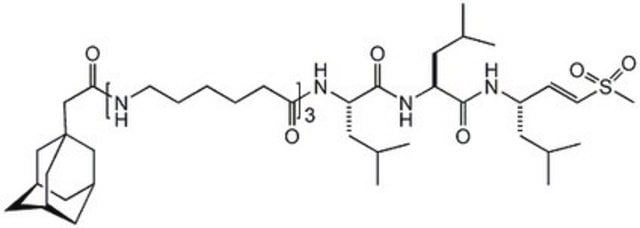11093037001
Roche
Chromozym t-PA
powder, 90% (enzymatic), 0.25 mM
Synonym(s):
N-Methylsulfonyl-D-Phe-Gly-Arg-4-nitranilide acetate
Sign Into View Organizational & Contract Pricing
All Photos(1)
About This Item
UNSPSC Code:
12352204
Recommended Products
Quality Level
assay
90% (enzymatic)
form
powder
mol wt
636.7
packaging
pkg of 20 mg
manufacturer/tradename
Roche
concentration
0.25 mM
storage temp.
20-25°C
Related Categories
General description
N-Methylsulfonyl-D-Phe-Gly-Arg-4-nitranilide acetate
Application
Use Chromozym® t-PA (tissue plasminogen activator) (C24H32N8O7S x CH3COOH) as a substrate for the determination of t-PA, both in purified preparations and in cell culture supernatants. Moreover, it can be applied to evaluate the content of one-chain and two-chain t-PA.
Quality
Purity: >90% (enzymatic)
Contaminant: <0.5% free 4-nitraniline
Contaminant: <0.5% free 4-nitraniline
Sequence
N-Methylsulfonyl-D-Phe-Gly-Arg-4-nitranilide-acetate
Preparation Note
Working concentration: Approximately 0.25 mM
Storage conditions (working solution): 2 to 8 °C
An aqueous solution of Chromozym t-PA (4mM) is stable for at least two weeks if stored at 2 to 8 °C.
Storage conditions (working solution): 2 to 8 °C
An aqueous solution of Chromozym t-PA (4mM) is stable for at least two weeks if stored at 2 to 8 °C.
Other Notes
For life science research only. Not for use in diagnostic procedures.
Legal Information
Chromozym is a registered trademark of Pentapharm AG, Basel
Storage Class
11 - Combustible Solids
wgk_germany
WGK 2
flash_point_f
Not applicable
flash_point_c
Not applicable
Certificates of Analysis (COA)
Search for Certificates of Analysis (COA) by entering the products Lot/Batch Number. Lot and Batch Numbers can be found on a product’s label following the words ‘Lot’ or ‘Batch’.
Already Own This Product?
Find documentation for the products that you have recently purchased in the Document Library.
Lucia Cilenti et al.
The Journal of biological chemistry, 278(13), 11489-11494 (2003-01-17)
Omi/HtrA2 is a mammalian serine protease with high homology to bacterial HtrA chaperones. Omi/HtrA2 is localized in mitochondria and is released to the cytoplasm in response to apoptotic stimuli. Omi/HtrA2 induces cell death in a caspase-dependent manner by interacting with
Our team of scientists has experience in all areas of research including Life Science, Material Science, Chemical Synthesis, Chromatography, Analytical and many others.
Contact Technical Service








